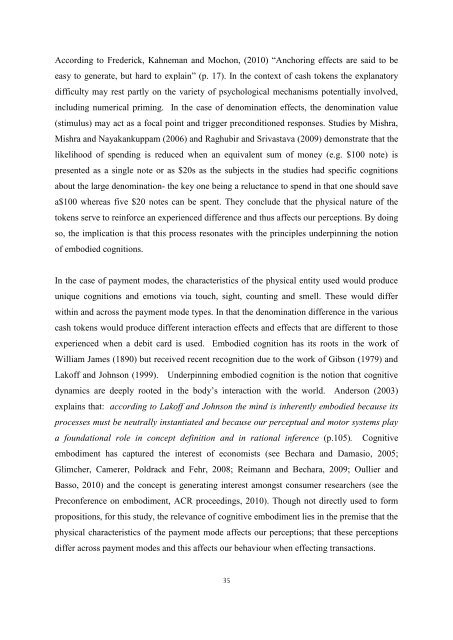Cash or Card: Consumer Perceptions of Payment Modes - Scholarly ...
Cash or Card: Consumer Perceptions of Payment Modes - Scholarly ...
Cash or Card: Consumer Perceptions of Payment Modes - Scholarly ...
Create successful ePaper yourself
Turn your PDF publications into a flip-book with our unique Google optimized e-Paper software.
Acc<strong>or</strong>ding to Frederick, Kahneman and Mochon, (2010) “Anch<strong>or</strong>ing effects are said to be<br />
easy to generate, but hard to explain” (p. 17). In the context <strong>of</strong> cash tokens the explanat<strong>or</strong>y<br />
difficulty may rest partly on the variety <strong>of</strong> psychological mechanisms potentially involved,<br />
including numerical priming. In the case <strong>of</strong> denomination effects, the denomination value<br />
(stimulus) may act as a focal point and trigger preconditioned responses. Studies by Mishra,<br />
Mishra and Nayakankuppam (2006) and Raghubir and Srivastava (2009) demonstrate that the<br />
likelihood <strong>of</strong> spending is reduced when an equivalent sum <strong>of</strong> money (e.g. $100 note) is<br />
presented as a single note <strong>or</strong> as $20s as the subjects in the studies had specific cognitions<br />
about the large denomination- the key one being a reluctance to spend in that one should save<br />
a$100 whereas five $20 notes can be spent. They conclude that the physical nature <strong>of</strong> the<br />
tokens serve to reinf<strong>or</strong>ce an experienced difference and thus affects our perceptions. By doing<br />
so, the implication is that this process resonates with the principles underpinning the notion<br />
<strong>of</strong> embodied cognitions.<br />
In the case <strong>of</strong> payment modes, the characteristics <strong>of</strong> the physical entity used would produce<br />
unique cognitions and emotions via touch, sight, counting and smell. These would differ<br />
within and across the payment mode types. In that the denomination difference in the various<br />
cash tokens would produce different interaction effects and effects that are different to those<br />
experienced when a debit card is used. Embodied cognition has its roots in the w<strong>or</strong>k <strong>of</strong><br />
William James (1890) but received recent recognition due to the w<strong>or</strong>k <strong>of</strong> Gibson (1979) and<br />
Lak<strong>of</strong>f and Johnson (1999). Underpinning embodied cognition is the notion that cognitive<br />
dynamics are deeply rooted in the body’s interaction with the w<strong>or</strong>ld. Anderson (2003)<br />
explains that: acc<strong>or</strong>ding to Lak<strong>of</strong>f and Johnson the mind is inherently embodied because its<br />
processes must be neutrally instantiated and because our perceptual and mot<strong>or</strong> systems play<br />
a foundational role in concept definition and in rational inference (p.105). Cognitive<br />
embodiment has captured the interest <strong>of</strong> economists (see Bechara and Damasio, 2005;<br />
Glimcher, Camerer, Poldrack and Fehr, 2008; Reimann and Bechara, 2009; Oullier and<br />
Basso, 2010) and the concept is generating interest amongst consumer researchers (see the<br />
Preconference on embodiment, ACR proceedings, 2010). Though not directly used to f<strong>or</strong>m<br />
propositions, f<strong>or</strong> this study, the relevance <strong>of</strong> cognitive embodiment lies in the premise that the<br />
physical characteristics <strong>of</strong> the payment mode affects our perceptions; that these perceptions<br />
differ across payment modes and this affects our behaviour when effecting transactions.<br />
35

















